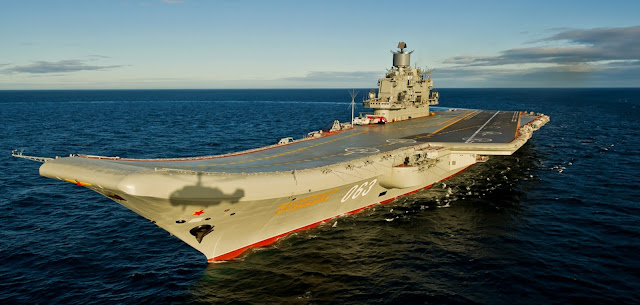Top 10 Largest Aircraft Carriers in World
What kind of an effect can they have in the face of a war that may come out? The floating cities of the countries are ready for any possible war. Some are in the project or construction phase.
10. HMS Queen Elizabeth- UK
10. HMS Queen Elizabeth- UK
The HMS Queen Elizabeth is scheduled to commission early
this year and will be the largest warship ever built for the Royal Navy. This
ship will be capable of carrying up to forty aircraft and has been named after
Queen Elizabeth II. It will be the lead ship of the Queen Elizabeth-class
aircraft carriers. The ship is not expected to be fully functional until the
year 2020 and will not be fitted with catapults arrestor wires, unlike other
large carriers, so it will only operate V/STOL aircraft.
The design of this carrier was to emphasize flexibility
and will be suited for 250 Royal Marines and will be able to support them with
attack helicopters and troop transports. This ship is the second Royal Navy
vessel to bear the name HMS Queen Elizabeth. She will call HMNB Portsmouth home
and will begin sea trials in March of this year.
9. Admiral Kuznetsov- Russia
The Admiral Kuznetsov is Russia’s only operational
aircraft carrier. It ranked as the second largest carrier and was built by
Black Sea Shipyard, which is the only manufacturer of their carriers. This ship
is considered an aircraft cruiser as she carries missiles in Russian
classification and serves as the flagship for the Russian Navy. Originally
commissioned to be the lead ship of her class, she turned out to be the only
other ship in the Russian Navy in this class. Varyag had been planned but never
completed or commissioned and was eventually sold to the Republic of China.
Kuznetsov was named after the Admiral of the Fleet of the
Soviet Union and has a displacement of more than 40,000 tons but is able to
reach more than 55,000 tons when at full military capacity. It had originally
been named, Riga and then launched as, Leonid Brezhnev. The carrier went on to
be renamed, Tbilisi when it embarked on its sea trials, and finally received
the name of, Admiral Kuznetsov.
8. INS Vikramaditya- India
INS Vikramaditya entered into the Indian Navy for service
in 2013. It has been named in honor or Vikramaditya who was a legendary first
century BC emperor of Ujjain, India. This vessel was originally built as Baku
and its first commission was in 1987. This carrier was with the Soviet and
Russian Navies before they decommissioned it in 1996 as the expenses to keep
her maintained were becoming too high. India purchased her in January 2004
after a lot of negotiations.
The INS Vikramaditya completed her
successful sea trials in July 2013 and her aviation trials in September of
2013. In November of 2013, she was formally commissioned at a ceremony at
Severodvinsk, Russia after extensive reconstruction efforts. She has a
displacement of over 45,000 tons. This is a larger full load displacement than
what she was originally designed for. She was re-fabricated with extensive
re-cabling done to support new radars and sensors. The elevators were also
upgraded, and two restraining stands were fitted to allow combat aircraft to
reach full power before making a ski-jump take-off.
7. Sao Paulo- Brazil
The Sao Paulo is currently in service with the Brazilian
Navy and was first commissioned in 1963 by the French Navy. It was transferred
to Brazil in 2000 where she became the new flagship of the Brazilian Navy. The
Sao Paulo was built in France between 1957 and 1960 where she served the French
Navy as the Foch. Brazil purchased her for $12 million (US dollars) in 2000
without any aircraft being part of the price.
The Sao Paulo has a displacement of more than 24,000 tons
but is able to reach more than 32,000 tons at full military capacity. In
December of 2014, it was decided this ship could no longer continue service
until 2039 which by then will make it an 80-year-old ship. This carrier has
suffered from issues which make it impossible to operate for more than three
months at a time before it requires more repairs and maintenance.
6. Juan Carlos I- Spain
The Juan Carlos I is considered a multi-purpose warship
in the Spanish Navy and is similar in design to the American Wasp-class
amphibious assault ship. This ship also has the addition of a ski jump and will
be equipped with an AV-8B Harrier II attack aircraft. It will be primarily used
as a plane carrier and has been named in honor of the current King of Spain,
Juan Carlos I. This new vessel will play a significant role in the fleet as it
will be the platform that will also support the mobility of the Marines and
strategic transport of ground troops.
The design of the Juan Carlos I was approved in September
of 2003. Its flight deck is over 600 feet and has eight landing spots. This is
the first ship in the Spanish Navy that will use diesel-electric propulsion
which connects both types of diesel and the new technology gas turbine. The
carrier will hold approximately 900 Navy personnel with their equipment and
almost 1,200 soldiers.
5. Cavour (550)- Italy
The Cavour is an Italian carrier and the Italian Navy’s
newest flagship. This ship has been named after Camillo Benso who was an
Italian politician and statesman and was launched in July of 2004. The design
of this carrier is to combine fixed wing V/STOL and helicopter air operations.
It will also hold command and control operations and transport civil and
military personnel along with heavy vehicles. The hanger on the Cavour can
double as a vehicle hold and will fit up to 24 main battle tanks or a large
number of lighter vehicles.
The Cavour has a displacement of more than 27,000 tons
but is capable of more than 30,000 tons when at full capacity. The Italian Navy
had planned to replace 16 of its Harriers with 15 Lockheed Martin F-35B
Lightning II. The schedule was not definite, but they proposed to modify the
Cavour to hold the F-35Bs by 2016. It was planned to support ten of the F-35Bs
in the hanger, and six more parked on the deck.
4. USS America (LHA-6)- United States
The USS America is the fourth warship from the United
States and will be the first amphibious assault ship for the U.S. Navy. Named
for the country she supports, this ship was delivered in 2013 and replaced the
USS Peleliu of the Tarawa class. Her role is to be the flagship of an
expeditionary strike group or the amphibious group which will carry Marines
from the expeditionary unit into battle. The design of the carrier is based on
USS Makin Island so she does not have a well deck which will allow for more
room for aviation facilities.
The USS America is an improved
version of its model with well deck being removed it allows for an extended
hangar deck with significantly wider bay areas which were fitted with an
overhead crane for maintenance on aircraft. Other improvements completed
include an onboard hospital, more aviation fuel capacity and more aviation
support spaces.
3. Charles de Gaulle- France
The Charles de Gaulle is the flagship of the French Navy,
and she also holds the title for the largest warship in Western Europe. She
holds other titles including; the first French nuclear-powered surface vessel,
first nuclear-powered carrier outside of the U.S., and the tenth French
aircraft carrier. The ship has been named after Charles de Gaulle and French
general and statesman. This warship is a CATOBAR-type carrier using 75 m C13.3
steam catapults at the bow and another at the front of the landing area. The
ship has a displacement of more than 37,000 tons and can reach more than 42,000
tons at full capacity.
The characteristics of this carrier allow it operate American aircraft such as the F/A-18E/F Super Hornet and the C-2 Greyhound which operate from American carrier vessels. The Charles de Gaulle replaced the Foch in 2001 after the replacement was identified in the mid-1970s. In 1989 the hull was laid down, and the carrier was put into construction in 1994 which fell behind due to starved funding. It wasn’t until May of 2001 before is was commissioned.
2. Liaoning- China
The Liaoning is the People’s Liberation Army Navy’s first
commissioned aircraft carrier. Classified as a training ship, the Liaoning was
intended to make it possible for the Navy to practice with transport usage.
This ship was originally the Admiral Kuznetsov in the Soviet Navy and launched
their service in 1988. It was later renamed Varyag. The People’s Republic of
China purchased the stripped hulk of the Vargag and towed it to the Dalian
Shipyard in China. She was completely rebuilt and went through sea trials
before being commissioned in 2012 and renamed the Liaoning.
The Liaoning is armed with Type 1030 CIWS, HQ-10
missiles, and anti-submarine warfare rocket launchers. It is capable of
displacing more than 59,000 and is powered by steam turbine propulsion. The
flight deck on this carrier can hold up to 50 aircraft which includes
helicopters and fixed wing planes.
1. Nimitz Class- United States
The Nimitz Class has a displacement of 97,000 tons when
fully loaded. This is the world’s largest aircraft carrier and the first in the
class deployed in 1975. Each of the Nimitz Class carriers has been designed to
stay in service for 50 years and need only one mid-life overhaul. Each of these
ships is more than 20 stories above the water and can hold more than 3,000 of
ship’s company, 500 crew members, and 1,500 air wing.
The ten carriers making up the Nimitz Class were all
constructed at the Newport News Shipbuilding Company, and the lead one was
commissioned in May of 1975. The tenth carrier in the Class was approved in
January of 2009. These ships have all participated in a significant number of
conflicts across the world including Iran, the Gulf War, and Afghanistan.
One of the biggest assets during wartime is the aircraft
carriers. Since they have been put into use, these ships have made a
significant impact for the defense of many countries. These are the top 10
largest aircraft carriers in the world and some that have made the biggest
differences in their countries wartime strategies.












Comments
Post a Comment